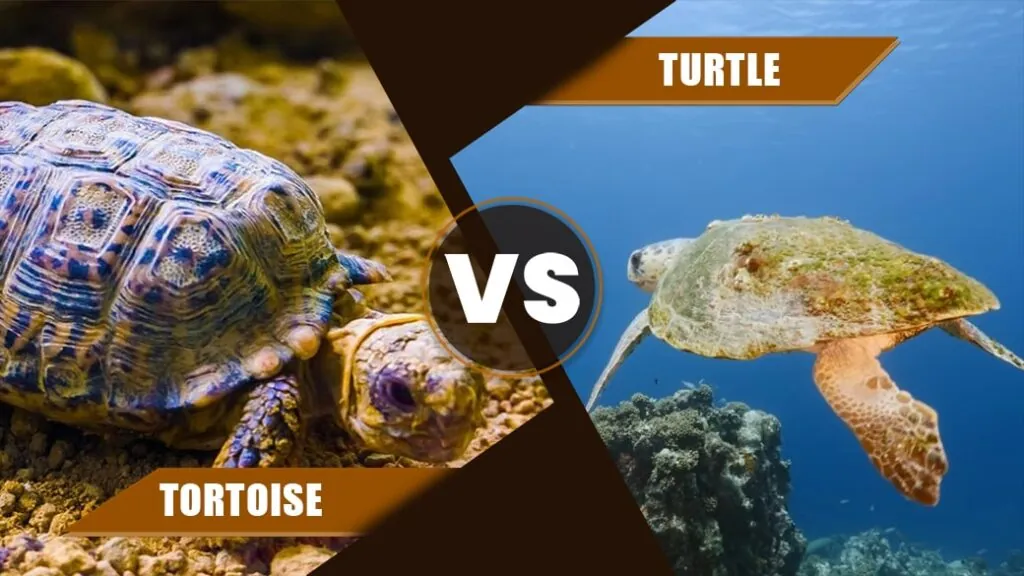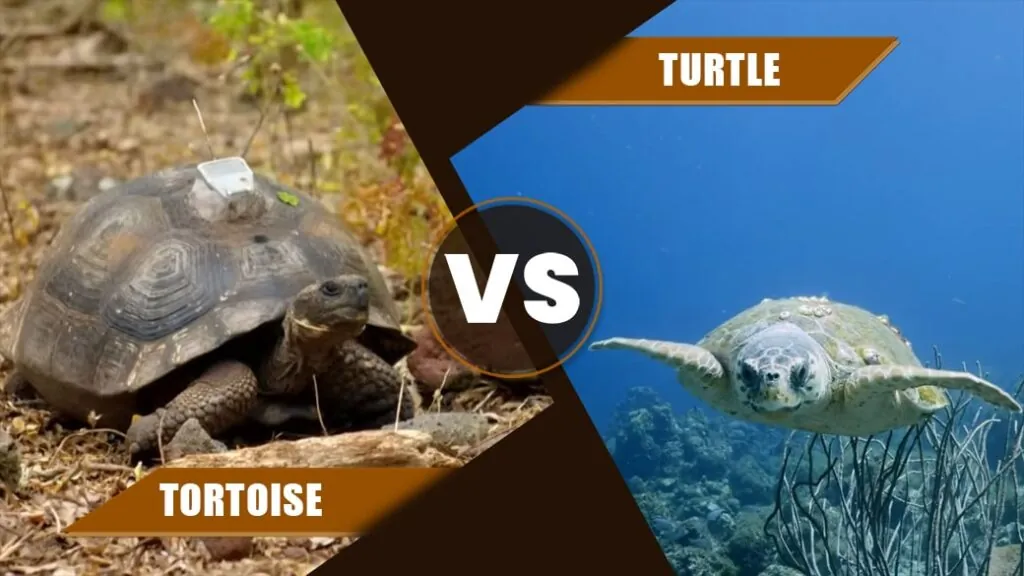Tortoise vs Turtle Choices: Playing the Shell Game Unveiled!

Have you ever find yourself giving a thought to the slow and steady realm of shell-donned wanderers, conjecturing if it’s a tortoise or a turtle that has grabbed your inquisitiveness? The terms “tortoise” and “turtle”, frequently used interchangeably, harbor a world of differences that span far beyond mere semantics. Buckle up for a journey into the shell-shocked world of “tortoise vs turtle”, where the lines between these creatures blur.
| Attribute | Tortoise | Turtle |
|---|---|---|
| Scientific Name | Testudinidae | Various families (e.g., Cheloniidae, Dermochelyidae) |
| Number of Species | 60 | 360 |
| Height | 10–15 cm (4–6 in) | 2.5 feet to 6.5 feet |
| Length | Varies by species – a few inches to over 4 feet | Varies by species – a few inches to over 6 feet |
| Weight | 70 to 100 pounds | 0.5 to 2,000 pounds |
| Top Speed | Slow walkers, usually under 1 mph (1.6 km/h) | Varies; some species can swim at speeds up to 22 mph (35 km/h) |
| Habitat | Primarily terrestrial, favoring dry land | Aquatic, semi-aquatic, and terrestrial habitats depending on the species |
| Prey / Diet | Herbivorous, primarily plant-based diet | Omnivorous, herbivorous, or carnivorous depending on the species |
| Lifespan | 80 to 150 | Varies; commonly 20-40 years, but some species can live longer |
| Distinctive Feature | Dome-shaped, land-adapted shell; sturdy limbs | Streamlined shell for aquatic life; flippers or webbed feet for swimming |
| Conservation Status | Not extinct | Endangered |
Cultural and Historical Significance
Throughout the course of history, tortoises and turtles have inspired thinkers and artists beyond myths. Getting inspiration from ancient myths and lasting folklore, these reptiles transcend the contours of mere biology.
Philosophical Depth
Diogenes, a renowned philosopher, used the image of a tortoise to illustrate the concept of self-sufficiency, making an addition of a philosophical layer to their cultural significance. This transcendent relation spotlights the timeless allure of these creatures.
Symbolic Connections
Turtles, across ancient cultures, are the icons of fertility, creation and protection in Egypt; on the part of tortoises, Native American folklore illustrated these reptiles as wise and patient beings.
Physical Characteristics
Size
When it comes to the size of tortoise, the Galapagos giant tortoise can tip the scales at a staggering 919 pounds, featuring the stretched range within tortoise family. On the flip side, the leatherback sea turtle, renowned for agility and speed in water, exhibits a stark contrast to its tortoise counterparts, hitting the lengths exceeding 7 feet and weigh up to 2,000 pounds.
Coat
With respect to the coat of tortoises – a worth-noticing aspect in the world of “tortoise vs turtle,” these reptiles wear their habitats on their backs with shells, showcasing earthy hues extending from browns to greens. On the other hand, the Hawksbill turtle, a living canvas beneath the waves, features intricately patterned shells.
Distinctive Features
The African spurred tortoise presents a touch of the exotic with a stunning lion’s mane-like growth on its neck, while the loggerhead turtle, having tear mark-like patterns on its face, introduces a factor of mystery and sophistication.
Habitat and Distribution
Spotlighting the habitat of tortoises, they’re resilient in varied landscapes, encompassing the arid deserts of North America to the lush islands of the Galapagos. In conjunction with the habitat of turtles, they thrive in diverse environments, with species like the Kemp’s ridley kicking off on epic migrations across oceans.
Population
With respect to the population of radiated tortoise – inhabiting Madagascar – has encountered a drastic decline in recent decades. Over the last 30 years, with an approximated population decline of 80%, the IUCN categorizes this species as “Critically Endangered.”
The Kemp’s ridley sea turtle, the smallest sea turtle species, faces substantial challenges. Predominantly concentrated in the Gulf of Mexico, the nesting population experienced a sharp reduction thanks to historical egg harvesting.
Behavior and Lifestyle

When it comes to the behavior and lifestyle of tortoises, they’re solitary beings with intriguing behaviors, reflecting patience and resilience. Loggerhead turtles showcase communal nesting behaviors, adding a layer of intricacy to their social dynamics.
Hunting Techniques
The herbivorous tortoise, methodically, grazes on vegetation, while the leatherback sea turtle, with its chiefly jellyfish-based diet, navigates the open ocean with a majesty that rivals its terrestrial equivalents.
Diurnal vs Nocturnal Activities
With the day the diurnal rhythm of tortoises harmonizes, whereas the nocturnal nesting habits of the leatherback sea turtle uncover a shadowy realm under the cover of darkness.
Speed and Strength
The deliberate and slow movements are what make tortoises conspicuous. Normatively, they can cover approximately 0.2 mph (0.3 km/h). The configuration of their short limbs and sturdy, domed shells isn’t conductive to swift locomotion. Contrastingly, the leatherback sea turtle, can reach the speeds of up to 22 mph (35 km/h); the very agility is pivotal for efficient navigation through ocean currents and dodging of predators. Speaking of the “speed”, how about have a glance at their antithesis – rabbit and hare.
In conjunction with the strength of tortoises, it lies in their ability to carry the weight of their extensive shells. This protective armor, serving not only as a shield but also as a mobile home, provides a secure refuge. In contrast, the strength of turtles is mirrored in their streamlined bodies and potent limbs, appropriate for swimming. Their strength is crucial for undertakings, such as migrations over stretched distances, deep-sea navigation and the quandaries of ocean life.
Conservation Status
A plethora of tortoise species find themselves on the edge of extinction. The radiated tortoise, scientifically known as Astrochelys radiate, inhabit Madagascar, is a glaring example – classified as “Critically Endangered.”
When it comes to the conservation status of turtles, it varies among species. The Kemp’s ridley sea turtle, scientifically referred to as Lepidochelys kempii, is “Critically Endangered” due to threats like incidental capture in fishing gear and habitat degradation.
In Popular Culture
Movies
Tortoises, while not as prominent as their faster equals, once in a blue moon make conspicuous appearances, for instance, a tortoise named “Slowpoke” embodies the concept of taking life at a more leisurely pace in “Master of Disguise” (2002).
On the flip side, turtles, specifically sea turtles, have garnered significant attention in popular movies. The animated classic “Finding Nemo” (2003) showcases Crush – a laid-back and wise sea turtle, providing a memorable portrayal. In addition, the “Teenage Mutant Ninja Turtles” franchise has become iconic, featuring turtles as agile and heroic beings laced with humorous acts.
Documentaries
The striking journeys of sea turtles are manifested in the documentaries like “The Blue Planet” and “Planet Earth,” underscoring their resilience and the obstacles they encounter in the wild.
Literature
As metaphors for steadfastness and resilience, tortoises are woven into the fabric of literature. In the fables of Aesop, tortoises are presented, instilling cherished life lesson, such as in “The Tortoise and the Hare.”
Turtles, signifying wisdom and longevity, find a prominent place in literature, for instance, in “Disworld” series by Terry Pratchett, Great A’Tuin – a giant turtle – carries the world on its back, operating as a metaphor for the cosmos and the enduring nature of existence.
Symbolic Meanings
Tortoises, esteemed for their enduring attributes, hold universal symbolism in cultures globally. In Eastern philosophies, specifically Hinduism, tortoise is regarded as an icon of wisdom and stability, personifying the capacity for thoughtful action and introspection.
On the flip side, turtles, particularly sea turtles, carry diverse symbolic meanings across cultures. Turtle, in a number of Asian societies, connects to the notion of longevity, signifying a life of prosperity and enduring fulfillment. Native American cultures, taking into consideration their shells as shields, attribute protective qualities to turtles. On the related note, got the scoop of World Turtle Day.





